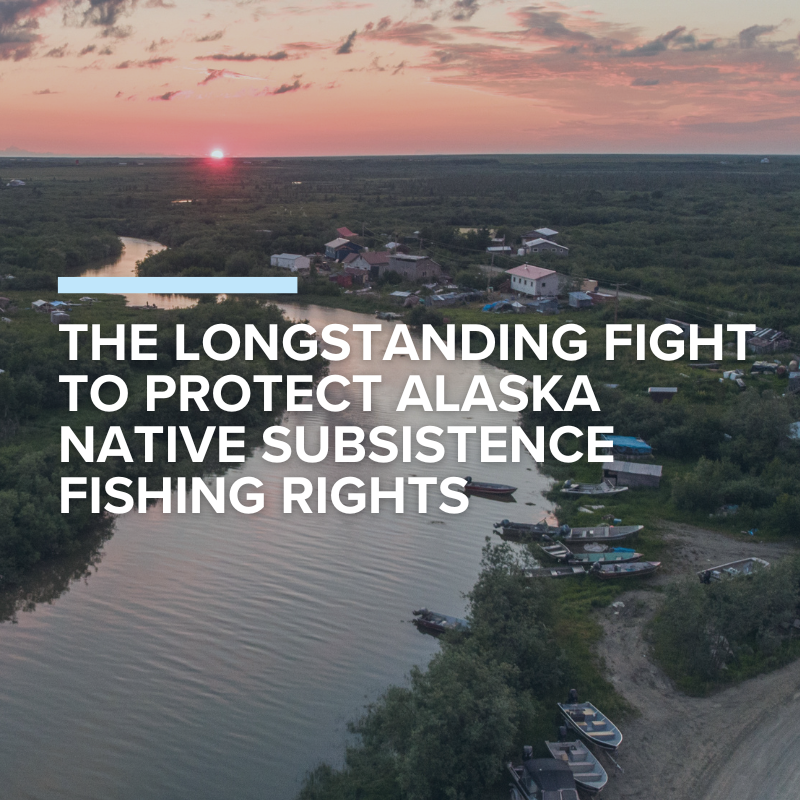By: Lily Cohen
November 17, 2025
Published as part of The Headwaters Report
For many Tribal Nations in Alaska, no issue matters more than subsistence fishing. Tribes have had to contend with commercial fishing, sport fishing, and the tens of thousands of urban Alaskans who participate in personal use fisheries. The importance of fish to so many Alaskans has led to persistent conflicts about who manages fishing on which waterways.

For decades, NARF represented Katie John, an Ahtna Athabaskan Indian and the daughter of the last chief of Batzulnetas. Katie John fought to sustain her way of life by protecting her right to subsistence fishing — the practice of harvesting fish for one’s family and community. Throughout decades of litigation that have become called the Katie John cases, the State of Alaska fought a federal law establishing a priority for rural subsistence fishing meant to protect the way of life for many Alaska Natives. Now, in what feels like the worst form of déjà vu, the state is fighting to overturn the precedents set by the Katie John cases. In August, the Ninth Circuit Court of Appeals once again upheld the federal rural subsistence priority. Because this recent victory cannot be understood without the background of the Katie John cases, this article provides an abbreviated history before turning to the current litigation.
Establishment of the rural subsistence priority
For generations, Katie John and her family subsistence fished at Batzulnetas, a revered fishing site on the Copper River. When Alaska became a state in 1959, the state government assumed management of hunting and fishing. By 1964, the state had completely closed subsistence fishing along the upper Copper River, preventing Katie John and other Tribal members from exercising their fishing rights and maintaining their way of life.
In 1980, Congress passed the Alaska National Interest Lands Conservation Act (ANILCA), which included two critical components to protect subsistence practices by Alaska Native people. First, ANILCA established 100 million acres of conservation system units such as national parks, preserves, and refuges that are managed by the federal government as federal public lands. Many areas critical for Tribal subsistence hunting and fishing were covered in those conservation system units. Second, Title VIII of ANILCA established a priority for rural subsistence hunting and fishing on federal “public lands” whenever it becomes necessary to restrict hunting and fishing in times of shortage. This ensured that Katie John’s ability to catch salmon would be prioritized over the needs of the commercial fishing industry. In enacting Title VIII, Congress recognized that subsistence fishing is essential to Alaska Natives’ physical, economic, traditional, and cultural existence.
Congress expected Alaska to manage the rural subsistence priority and provided multiple extensions to allow for the State to assume management responsibility under ANILCA. Unfortunately, the State failed to enact an enduring subsistence priority for rural residents. Therefore, in 1990, the Departments of the Interior and Agriculture established the Federal Subsistence Board to manage subsistence resources on federal public land and waters. The board includes voting members who represent rural subsistence users. This enables people who rely on subsistence to have direct input into decisions.
The state has consistently argued that the federal government cannot regulate fishing on navigable waters such as the Copper River. Roughly speaking, a river is a “navigable water” if someone can comfortably paddle down it in a large raft. That means all major salmon bearing rivers in Alaska are navigable waters. At statehood, the federal government transferred ownership of the land beneath navigable waters to Alaska. Therefore, the state argues that it has management authority over what happens in navigable waters. The state wants to manage fishing on rivers even if they run through federally owned land that ANILCA designated as part of a conservation system unit. However, that argument does not make sense when considering ANILCA’s goal of protecting subsistence fishing. If ANILCA excludes major salmon rivers, it cannot protect subsistence fishing.
Over the course of what is now known as the Katie John trilogy,[1] the Ninth Circuit repeatedly rejected the state’s arguments. The court repeatedly held that “public lands,” as defined in ANILCA, include navigable waters in which the United States holds reserved water rights. Under the reserved waters doctrine, whenever the federal government withdraws lands from the public domain for a federal purpose, it implicitly reserves water necessary to accomplish the purposes of the reservation. (See our Water Rights 101 to learn more about the reserved waters doctrine). The Ninth Circuit held that it was clear that Congress intended to protect subsistence fishing when withdrawing public lands in Alaska in ANILCA to establish conservation system units. Therefore, Title VIII’s subsistence priority applies to navigable waters running through or alongside federal public lands, which covers about 50% of Alaska’s inland rivers.
A hovercraft challenges the extent of reserved water rights under ANILCA
In 2019, the U.S. Supreme Court issued an opinion in Sturgeon v. Frost[2] about whether the reserved water rights doctrine enabled the federal government to regulate navigable waters in Alaska. Sturgeon was using a hovercraft (effectively a type of boat) within a national preserve to access a private inholding that was expressly exempt under ANILCA Title I from federal regulation. The National Park Service prohibited hovercrafts in the preserve. Sturgeon brought a challenge, arguing that the National Park Service did not have the authority to regulate what types of boats could travel along the rivers going through a national preserve. Alaska filed a brief in support of Sturgeon, once again arguing that the state has regulatory authority over navigable waters because they own the land beneath. However, the state explicitly asserted that ruling in his favor should not disturb the Katie John trilogy. The Court sided with Sturgeon and held that the National Park Service did not have the authority to issue regulations about types of travel on navigable waters within the national preserve. In deciding Sturgeon, the Supreme Court relied on this assertion from the state and specifically stated that it was not disturbing Katie John.
The State of Alaska renews its fight to overturn the Katie John trilogy
Following the Sturgeon decision, Alaska changed its position and is now arguing that Sturgeon effectively overruled Katie John. The state asserts that it has the authority to manage rivers within federal conservation units and is once again fighting to erase Title VIII’s protection of rural subsistence fishing.
In 2021, the U.S. Fish and Wildlife Service issued emergency orders closing the Kuskokwim River to salmon fishing due to the collapsing salmon fishery along the river. However, the FWS provided five dates for federally qualified rural subsistence users living along the Kuskokwim to fish for salmon. The state also closed the river to salmon fishing, but emboldened by Sturgeon, the state opened subsistence fishing along the river for the same dates. Unlike the Federal Wildlife Service, the state opened fishing to all Alaskans, regardless of whether they live along the river and depend on salmon.
In 2022, the Wildlife Service again closed the Kuskokwim River to salmon fishing, and again provided five dates for federally qualified rural subsistence users living along the Kuskokwim to fish for salmon. Again, the state also closed the river to salmon fishing, except for three of the same dates provided by the federal agency. Again, the state allowed subsistence fishing by all Alaskans.
The federal government then sued Alaska arguing that the state’s fishing openers violated ANILCA Title VIII because they conflicted with the Federal Wildlife Service’s orders and failed to provide for the rural subsistence priority. The federal government sought an injunction to prevent Alaska from issuing conflicting fishing regulations. NARF intervened on behalf of our clients, the Association of Village Council Presidents (a consortium representing 56 Tribes in western Alaska) and two individual federally qualified rural subsistence fishers. Multiple other organizations representing subsistence users also intervened to fight against the state’s position. In 2024, the Alaska Federal District Court rejected the state’s argument. The State of Alaska appealed.
In August, the Ninth Circuit Court of Appeals again rejected Alaska’s argument that ANILCA does not apply to navigable waters.[3] The panel affirmed the Katie John trilogy. The opinion opened by highlighting that Alaska’s argument is a complete reversal of its position, even though the Supreme Court decision in Sturgeon expressly relied on the State’s former position. The Ninth Circuit held that Sturgeon and Katie John were not irreconcilable because they interpreted different sections of ANILCA, with different purposes, and because Congress had ratified the Katie John decisions with amendments to ANILCA through several appropriations acts. Judge Callahan wrote, “Although Katie John, the Ahtna woman who advocated for subsistence fishing rights on behalf of Alaska Natives, has since passed away, the precedent that bears her name lives on.”
The state continues to fight against the rural subsistence priority and has asked the Supreme Court to reverse the Ninth Circuit decision and overrule Katie John. Meanwhile collapse of the salmon populations in the Kuskokwim River remains an existential crisis for Tribes, Alaska Natives, and rural Alaskans that depend on those salmon. The state’s resources would be better spent working to restore salmon populations in the river instead of relitigating the Katie John trilogy.
Endnotes
[1] Alaska v. Babbitt (Katie John I), 72 F.3d 698, 704 (9th Cir. 1995), cert. denied, 517 U.S. 1187 (1996), and cert. denied sub nom., Alaska Fed’n of Natives v. United States, 517 U.S. 1187 (1996); John v. United States (Katie John II), 247 F.3d 1032 (9th Cir. 2001) (en banc) (per curiam); John v. United States (Katie John III), 720 F.3d 1214, 1245 (9th Cir. 2013), cert. denied sub nom., Alaska v. Jewell, 572 U.S. 1042 (2014).
[2] Sturgeon v. Frost, 587 U.S. 28 (2019).
[3] United States v. Alaska, 151 F.4th 1124 (9th Cir. 2025).
More blog posts

